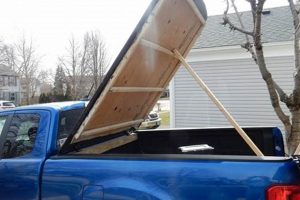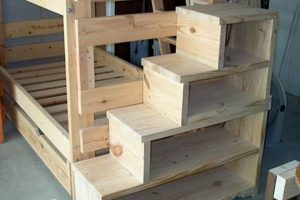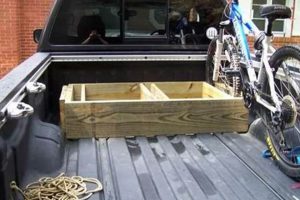Constructing a customized bicycle carrier for a pickup truck bed involves creating a system, typically from readily available materials, designed to securely transport bicycles within the cargo area of the vehicle. This method offers an alternative to commercially produced racks, potentially reducing costs and allowing for customization to specific bicycle types and bed dimensions. An example would be building a wooden frame with fork mounts attached, allowing the bicycles to stand upright and be stabilized.
The advantages of such projects lie in their adaptability and potential for significant cost savings compared to purchasing pre-made solutions. Historically, individuals have sought to create their own solutions for transporting goods and equipment, reflecting a spirit of resourcefulness and self-reliance. Furthermore, building a custom carrier allows for tailored design, accommodating unique bicycle sizes, shapes, and quantities, while also maximizing space utilization within the truck bed.
The subsequent sections will delve into the various design considerations, material options, and step-by-step instructions required for successfully fabricating a durable and effective bicycle transport solution for a pickup truck.
Essential Guidance for Creating a Truck Bed Bicycle Carrier
The following recommendations provide critical insights for constructing a safe and effective bicycle carrier for a pickup truck bed. Careful consideration of these points will contribute to a secure and reliable transport solution.
Tip 1: Prioritize Stability. The racks design must ensure bicycles remain upright and stable during transit. Utilize fork mounts, wheel cradles, or a combination thereof to minimize movement and prevent damage.
Tip 2: Employ Durable Materials. Select materials capable of withstanding the rigors of transport and environmental conditions. Treated lumber, steel, or durable plastics are suitable options, contingent on the design and weight requirements.
Tip 3: Secure Attachment Points. The carrier must be securely attached to the truck bed to prevent shifting or dislodging during travel. Utilize existing tie-down points or install additional anchors as needed.
Tip 4: Consider Bicycle Compatibility. Account for varying bicycle frame sizes and types when designing the carrier. Adjustable features or modular components can enhance compatibility with a wider range of bicycles.
Tip 5: Protect Bicycle Finishes. Implement padding or protective coverings at contact points to prevent scratching or damage to bicycle frames. Foam tubing or rubberized coatings offer effective protection.
Tip 6: Plan for Accessibility. Design the carrier to allow for easy loading and unloading of bicycles. Consider the height of the truck bed and the weight of the bicycles when determining the loading mechanism.
Tip 7: Adhere to Safety Regulations. Ensure the carrier does not obstruct the drivers view or violate any local or federal transportation regulations. Properly secure all bicycles to prevent hazards to other motorists.
These guidelines emphasize the importance of stability, durability, and compatibility in the fabrication process. Adhering to these principles will result in a bicycle carrier that effectively protects bicycles and ensures safe transport.
The subsequent section provides a comprehensive overview of material selection and construction techniques applicable to building a customized truck bed bicycle carrier.
1. Material Durability
Material durability is a cornerstone of any successful “truck bed bike rack diy” project. The materials selected directly influence the rack’s lifespan, its ability to withstand environmental conditions, and its capacity to safely secure bicycles during transit. A rack constructed from inferior materials is susceptible to premature failure, potentially leading to bicycle damage or, in extreme cases, accidents. For instance, untreated wood exposed to moisture and sunlight will warp, rot, and weaken over time, compromising the rack’s structural integrity. Similarly, thin-gauge steel susceptible to rust will quickly degrade, diminishing its load-bearing capacity. Therefore, selecting robust, weather-resistant materials is crucial for ensuring a durable and reliable bicycle carrier.
Consider the practical implications of material choice. A rack built from pressure-treated lumber, powder-coated steel, or durable composite materials will offer greater resistance to the elements and physical wear and tear. These materials possess inherent properties that protect against moisture, corrosion, and impact damage, extending the rack’s operational life. Furthermore, the fasteners used in construction screws, bolts, and brackets should also be selected for their durability and resistance to corrosion. Stainless steel hardware, for example, is highly resistant to rust and is a suitable choice for outdoor applications. The extra investment in high-quality materials yields a demonstrably more reliable and long-lasting bicycle carrying solution.
In conclusion, material durability is not merely a desirable attribute but a fundamental requirement for any “truck bed bike rack diy” undertaking. Selecting appropriate materials is a crucial element that mitigates the risks of premature failure and ensures long-term reliability, providing a secure method for transporting bicycles. Neglecting material durability invites potential problems, ultimately undermining the project’s objective.
2. Secure Mounting
Secure mounting is an indispensable aspect of any successful truck bed bicycle carrier construction. It directly impacts the safety of both the bicycles being transported and other vehicles on the road. A poorly secured rack can shift during transit, leading to potential damage to the bicycles, the truck bed, or even creating a road hazard.
- Attachment Point Integrity
Attachment point integrity concerns the strength and reliability of the points where the bicycle carrier connects to the truck bed. These points must be capable of withstanding the forces generated during acceleration, braking, and cornering. Examples include using heavy-duty tie-down straps connected to existing bed anchors or installing reinforced mounting plates. Insufficient attachment point integrity can result in the carrier breaking free, posing a significant safety risk.
- Rack Stability
Rack stability refers to the carrier’s ability to maintain its position within the truck bed. A stable rack minimizes movement and prevents bicycles from swaying or colliding with each other. Factors influencing rack stability include the rack’s design, weight distribution, and the tightness of the securing mechanisms. A rack that is not properly stabilized is more likely to shift during transit, increasing the risk of damage.
- Bicycle Fixation
Bicycle fixation involves securely attaching the bicycles to the carrier. This can be achieved through various methods, such as fork mounts, wheel straps, or frame clamps. The fixation method must be appropriate for the type of bicycle being transported and should prevent movement or slippage. Improperly secured bicycles can rub against the carrier or each other, causing scratches or more severe damage.
- Load Distribution
Load distribution refers to the way the weight of the bicycles is distributed across the truck bed. An evenly distributed load is essential for maintaining stability and preventing excessive stress on any single point. Uneven load distribution can affect the truck’s handling and increase the risk of the carrier tipping or collapsing. Consideration should be given to the positioning of bicycles within the carrier to achieve optimal weight distribution.
These elements of secure mounting ensure the bicycles and the carrier remain firmly in place throughout transport. Failure to address these considerations can compromise the safety and integrity of the entire system, highlighting the importance of thorough planning and execution in every stage of the DIY process. Implementing robust secure mounting practices is non-negotiable for a successful truck bed bicycle carrier build.
3. Bicycle Compatibility
Bicycle compatibility constitutes a critical design parameter in any successful “truck bed bike rack diy” project. The variability in bicycle frame geometries, wheel sizes, and component configurations necessitates careful consideration to ensure the rack can accommodate the intended bicycles securely and without damage. Failure to address bicycle compatibility results in a rack that may only be suitable for a limited subset of bicycles, rendering it impractical for many users. For example, a rack designed solely for road bikes with standard wheelbases may be entirely unsuitable for mountain bikes with longer wheelbases and wider tires.
A practical example illustrating the importance of bicycle compatibility is the construction of a fork-mount rack. While effective for securing bicycles with rigid forks and standard quick-release skewers, this design is incompatible with bicycles featuring thru-axle forks or suspension forks. Adapting the rack to accommodate these variations requires either designing a modular system with interchangeable mounts or creating a universal mount that can accommodate a wider range of fork types. Similarly, considerations must be made for bicycles with disc brakes, ensuring adequate clearance between the brake calipers and the rack structure. Neglecting these nuances can lead to friction, damage, or an inability to properly secure the bicycle.
In summary, bicycle compatibility directly influences the functionality and versatility of a “truck bed bike rack diy” project. Designers must account for the diverse range of bicycle types and configurations to create a rack that is adaptable, secure, and avoids causing damage. Prioritizing bicycle compatibility enhances the rack’s practical value and ensures it can accommodate a broader range of bicycles, thereby maximizing its utility. Overlooking this aspect introduces limitations and potential problems, reducing the overall effectiveness of the DIY solution.
4. Space Optimization
Space optimization constitutes a critical consideration in the context of “truck bed bike rack diy” projects. The available area within a pickup truck bed is finite, necessitating efficient use of this space to accommodate both bicycles and other potential cargo. Inefficient space utilization can lead to a reduced carrying capacity for other essential items, thereby diminishing the truck’s overall utility. A poorly designed bicycle carrier can occupy a disproportionate amount of the bed space, restricting the ability to transport tools, equipment, or luggage alongside the bicycles. This limitation directly impacts the practicality and versatility of the truck as a multi-purpose vehicle.
Effective space optimization in the design of a custom bicycle carrier involves several key strategies. Vertical stacking or angled positioning of bicycles can minimize the footprint of the rack within the truck bed. Utilizing the available height above the bed rails, while ensuring that the overall height remains within legal limits, can create additional storage space underneath the bicycles. Furthermore, a modular design that allows for easy removal or reconfiguration of the rack components when not in use maximizes the flexibility of the truck bed. An example could be a rack that folds flat against the bed sides when not transporting bicycles, freeing up the majority of the bed space for other items. Considerations should also extend to accommodating different bicycle types and sizes within the optimized space, ensuring compatibility across a range of potential cargo.
In conclusion, space optimization plays a pivotal role in determining the success of a “truck bed bike rack diy” project. By carefully considering the available dimensions and implementing efficient design strategies, it is possible to create a bicycle carrier that maximizes the utility of the truck bed without compromising its primary function. Addressing this aspect ensures that the truck remains a versatile and practical vehicle, capable of transporting both bicycles and other necessary cargo efficiently.
5. Cost Effectiveness
Cost effectiveness is a primary motivator for engaging in “truck bed bike rack diy” projects. Building a customized bicycle carrier offers the potential for significant savings compared to purchasing commercially manufactured racks, particularly those with advanced features or specialized designs. The degree of cost-effectiveness, however, is contingent upon material selection, design complexity, and the availability of existing tools and resources.
- Material Sourcing and Pricing
Material sourcing significantly influences the overall cost. Reclaimed or repurposed materials, such as lumber from pallets or recycled metal, can substantially reduce expenses. Conversely, opting for premium materials like stainless steel or specialized mounting hardware will increase the project’s budget. The availability of local suppliers and the ability to negotiate prices further impact cost-effectiveness. Online marketplaces can offer competitive pricing, but shipping costs must be factored into the calculation. Thorough research and comparison of material costs are essential for maximizing savings.
- Design Complexity and Labor
Design complexity directly correlates with labor requirements and potential material waste. A simpler design, utilizing readily available materials and straightforward construction techniques, minimizes both time and material costs. Intricate designs, requiring specialized tools or advanced fabrication skills, increase labor time and may necessitate professional assistance, thereby diminishing cost-effectiveness. The time invested in planning, measuring, and cutting materials should be considered, as mistakes can lead to material wastage and increased expenses.
- Tool Availability and Investment
The availability of necessary tools and equipment is a crucial factor. If a workshop is already equipped with essential tools like saws, drills, and welding equipment, the cost of the project is significantly reduced. However, if tools must be purchased or rented, the initial investment can offset the potential savings of a DIY approach. Renting specialized tools for short-term use may be a more cost-effective option than purchasing them outright. Additionally, borrowing tools from friends or family can further minimize expenses.
- Long-Term Value and Durability
While initial cost savings are attractive, long-term value and durability must be considered. A rack constructed from inferior materials may require frequent repairs or replacement, ultimately negating the initial cost advantage. Investing in durable materials and robust construction techniques ensures longevity, reducing the total cost of ownership over time. A well-built “truck bed bike rack diy” solution, designed for years of reliable service, represents a more cost-effective investment than a cheaply made commercial alternative that requires frequent replacement.
The interplay of material sourcing, design complexity, tool availability, and long-term durability ultimately determines the cost-effectiveness of a “truck bed bike rack diy” project. Careful planning, efficient resource utilization, and a focus on durability are essential for realizing the potential cost savings and creating a valuable, long-lasting bicycle transport solution.
6. Simplified Loading
The ease with which bicycles can be loaded and unloaded from a truck bed bicycle carrier significantly influences its usability and overall satisfaction. A design that streamlines this process reduces physical strain, minimizes the risk of damage to the bicycles or the truck, and saves time. Therefore, “simplified loading” is a crucial design objective in “truck bed bike rack diy” projects.
- Rack Height and Accessibility
The height of the bicycle carrier relative to the truck bed floor directly impacts the effort required for loading. A low-profile rack minimizes lifting height, making it easier to maneuver bicycles into position. Ramps or integrated loading platforms can further simplify the process, particularly for heavier bicycles. Conversely, a rack that positions bicycles high above the bed floor necessitates significant lifting, potentially leading to strain or injury. Design considerations should account for the average user’s physical capabilities and the weight of the bicycles being transported.
- Mounting Mechanism Efficiency
The design of the mounting mechanism plays a pivotal role in simplifying loading. Quick-release clamps, ratcheting straps, or self-centering fork mounts streamline the process of securing bicycles to the rack. Mechanisms that require complex adjustments or extensive tightening procedures increase the time and effort required for loading. The ease of use and intuitive nature of the mounting mechanism directly influence the efficiency of the loading process. A well-designed mechanism allows for quick and secure attachment with minimal physical exertion.
- Clearance and Obstruction Management
Adequate clearance around the rack and bicycles is essential for simplified loading. Sufficient space allows for easy maneuvering of bicycles into position without obstruction from the truck bed sides, wheel wells, or other rack components. The rack design should minimize protrusions or sharp edges that could impede the loading process or cause damage to the bicycles. Strategically positioning bicycles within the rack to maximize clearance and minimize interference streamlines the loading procedure.
- Intuitive Design and User Interface
An intuitive design, with clearly marked attachment points and straightforward operating procedures, is paramount for simplified loading. The user interface should be self-explanatory, minimizing the need for detailed instructions or specialized knowledge. Color-coded components or visual cues can assist in identifying attachment points and ensuring correct bicycle positioning. A well-designed user interface reduces the learning curve and minimizes the potential for errors during the loading process, contributing to a more efficient and user-friendly experience.
These facets of simplified loading are integral to the overall success of a “truck bed bike rack diy” endeavor. A design that prioritizes ease of use enhances the practicality and value of the rack, encouraging frequent and convenient bicycle transport. Overlooking these considerations can result in a cumbersome and time-consuming loading process, diminishing the user experience and potentially discouraging the use of the rack.
7. Structural Stability
Structural stability is a non-negotiable requirement in “truck bed bike rack diy” projects. The integrity of the entire bicycle transport system hinges on the rack’s ability to withstand static and dynamic loads encountered during transit. Insufficient structural stability manifests as flexing, bending, or even catastrophic failure of the rack, potentially resulting in damage to bicycles, the truck itself, or creating a hazard for other motorists. Therefore, robust design and construction practices are essential to guarantee the rack’s load-bearing capacity and resistance to deformation under stress. Consider, for example, a rack fabricated from undersized lumber or inadequately welded steel tubing. Such a construction may initially appear functional but will likely exhibit instability under the weight of multiple bicycles, particularly when subjected to the forces of acceleration, braking, and cornering. This instability can lead to component fatigue, eventual failure, and the potential loss of the transported bicycles.
Proper structural stability involves careful consideration of material properties, joint design, and load distribution. Material selection should prioritize strength and stiffness, opting for materials like steel, aluminum, or reinforced composites that possess a high strength-to-weight ratio. Joint design must ensure secure connections between structural members, employing welding, bolting, or adhesive bonding techniques that provide adequate load transfer. Load distribution should minimize stress concentrations, spreading the weight of the bicycles evenly across the rack structure and the truck bed. One illustrative example involves a “truck bed bike rack diy” project using steel tubing. The tubing gauge, weld quality, and gusset placement are all critical to prevent buckling or cracking under load. Similarly, the method used to secure the rack to the truck bedwhether through tie-downs, bed rails, or direct boltingmust be robust enough to resist the forces generated during travel. Neglecting any of these factors compromises the overall structural stability of the rack and increases the risk of failure.
In summary, structural stability is paramount for the safety and reliability of any “truck bed bike rack diy” solution. It is not merely an aesthetic consideration but a fundamental engineering requirement that dictates the rack’s ability to perform its intended function without compromising safety or causing damage. Meticulous attention to material selection, joint design, and load distribution is crucial to ensure the rack can withstand the rigors of transportation and provide years of reliable service. Prioritizing structural stability is, therefore, an indispensable element of any successful DIY truck bed bicycle carrier project.
Frequently Asked Questions
This section addresses common inquiries and concerns regarding the construction of a bicycle carrier for a pickup truck bed, offering guidance based on practical experience and engineering principles.
Question 1: What is the minimum material strength required for a safe and reliable rack?
The minimum material strength is contingent upon the number and weight of bicycles to be transported. Steel is generally preferred for its high tensile strength, while aluminum offers a lighter-weight alternative with reduced strength. A static load test should be conducted to verify the rack’s capacity to withstand the intended weight with a safety factor of at least 1.5.
Question 2: How can galvanic corrosion be prevented when using dissimilar metals?
Galvanic corrosion, which occurs when dissimilar metals are in contact in the presence of an electrolyte, can be prevented through several methods. These include using a barrier coating, such as paint or powder coating, on one or both metals, inserting a non-conductive spacer between the metals, or using a sacrificial anode, such as zinc, to corrode in place of the more critical metals.
Question 3: What are the legal requirements regarding visibility of taillights and license plates?
Federal and local regulations mandate that taillights and license plates remain clearly visible at all times. If the bicycle carrier obstructs these, supplemental taillights and a license plate bracket must be installed to comply with legal requirements and ensure safe operation on public roads.
Question 4: How should the rack be secured to the truck bed to prevent movement during transit?
The rack should be secured to the truck bed using robust tie-down straps, bed bolts, or a combination thereof. Attachment points should be evenly distributed to distribute the load and prevent concentrated stress. Consider using existing bed anchors or installing additional anchors if necessary, ensuring that the attachment method is rated to withstand the expected forces during acceleration, braking, and cornering.
Question 5: What is the best method for protecting bicycle frames from scratches and abrasions?
Bicycle frames can be protected from scratches and abrasions by applying padding to all contact points between the rack and the bicycle. Foam tubing, rubberized coatings, or cloth padding can be used to create a protective barrier. Ensure that the padding is securely attached to prevent it from shifting or falling off during transport.
Question 6: How can the rack be designed to accommodate different bicycle frame sizes and types?
To accommodate different bicycle frame sizes and types, an adjustable or modular design is recommended. Adjustable fork mounts, sliding wheel cradles, or removable frame supports can adapt to varying bicycle geometries. Consider incorporating multiple mounting points to accommodate different wheelbases and tire widths.
The information provided in this section offers guidance on addressing key challenges and considerations when constructing a bicycle carrier for a pickup truck bed. Adhering to these principles promotes safety, reliability, and legal compliance.
The subsequent section will provide detailed step-by-step instructions for constructing a sample bicycle carrier design, illustrating the practical application of the concepts discussed thus far.
Concluding Remarks on Fabricating a Truck Bed Bicycle Carrier
The preceding sections have comprehensively explored the multifaceted considerations inherent in constructing a “truck bed bike rack diy” solution. From material selection and structural integrity to bicycle compatibility and secure mounting, each aspect contributes to the overall safety, reliability, and practicality of the finished product. Careful attention to these details is paramount for mitigating risks and ensuring a long-lasting, functional bicycle transport system.
The decision to undertake such a project should be informed by a thorough understanding of the required skills, resources, and regulatory requirements. By adhering to sound engineering principles and prioritizing safety, it is possible to create a customized bicycle carrier that meets specific needs and provides years of reliable service. However, if uncertainty prevails regarding any aspect of the fabrication process, seeking professional assistance or considering commercially available options remains a prudent course of action.







